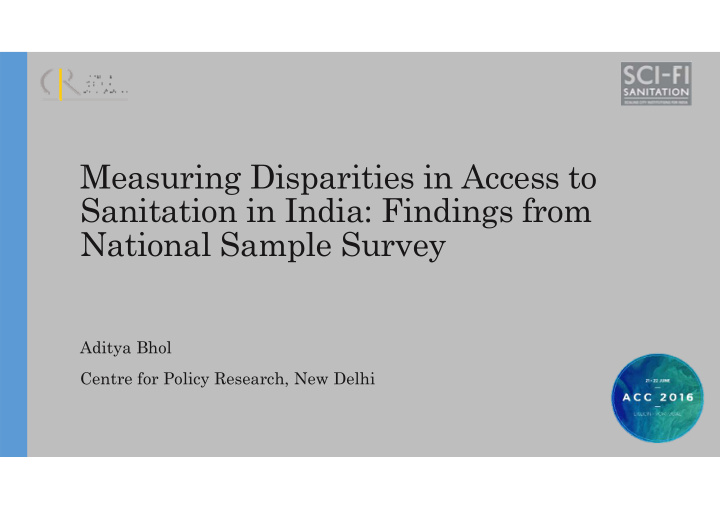



Measuring Disparities in Access to Sanitation in India: Findings from National Sample Survey Aditya Bhol Centre for Policy Research, New Delhi
Key Discussion Points • Latest urban sanitation statistics in India. Data from Census and NSS data. • Benefits of NSS data for multivariate analysis • Key Research Questions • Results of logistic analysis to measure state-wise disparities • Policy Implications : Using the results of the analysis to interpret the impact of current sanitation programmes and schemes
Urban Sanitation in India Statistics: • Toilets: In-house toilets - 81% Improved Toilets – 79% Piped Sewer – 38% On- site Systems( Septic tanks and Improved Pits) – 47% No Toilets – 19% Public Toilets – 6% Open Defecation – 13% (Census, 2011) • Drainage: Closed Drains – 45%, Open Drains – 37% and No Drains – 18% (Census, 2011) • Sewerage Treatment Facilities – 152 STPs [9 STPs under construction, 30 STPs non-operational and performance of 28 STPs not satisfactory] (CPCB, 2013) Definition of Environmental Sanitation - Safe confinement, treatment and disposal of human toilet waste and associated hygiene-related practices; solid waste management; generation of industrial and other specialized / hazardous wastes; drainage; and the management of drinking water supply (National Urban Sanitation Policy, 2008)
Insights from Data (NSS Data) • Advantages: Large sample size – 95,548 households (53,393 rural and 42,155 urban households surveyed) Samples considered for the study – 32,321 sampled households from 15 selected states Adequate representation of different regions of India Pertinent questions on water, sanitation and hygiene were included in the survey questionnaire Includes questions on various socio-economic indicators and housing conditions. Also includes consumption expenditure of households Allows generation of cross-tables • Disadvantages: Ambiguities in certain questions (wastewater outlets, land holdings) Census towns are included in urban sector
Access to services across consumption quintiles Access to Toilets across Consumption Quintiles: Note: Moving from poorest to richest quintiles the percentage of households with no toilets and no drains are declining but they still exist. This lead to the presumption that consumption or income could not be the only factors causing deprivation of Access to Drains across Consumption Quintiles resources.
Research Questions of the Study • What kind of disparities exist in the urban water and sanitation sectors in India? Exploration of different inequalities (vertical and horizontal) that are presumed to perpetuate deprivation of sanitation services • Vertical inequalities: Inequalities along consumption (proxy for income) expenditure of households • Horizontal Inequalities: Disparities in access to drainage Disparities in access to water supply Social Stratification (Caste Group) Spatial Stratification (Slum/Non-Slum) • What are the degrees of association between access to toilets and socio- economic indicators? • Are there state-wise disparities in access to sanitation? • What are the implications of the study on ongoing water and sanitation programmes?
Logistic Model for Analysis � 1 1 � �� � ��� ������ � � ����� � � log� � � 1 � � �� and � � � � � 1 � 1 � � 2 � 2 � ⋯� � � � � Where, ���� ����� ��� ����/100 ���� ��� � ��������� ���� ������ ��� ����� �� 100 �������� �� ���� � ���� ��� � ��������� ������� ������ ��� ����� �� 100 �������� �� ���� P � IHL�1|MPCE�M�100 � /P � IHL�1|MPCE�M � P � IHL�0|MPCE�M�100 � /P � IHL�0|MPCE�M � � ��� � ���� � The independent variables (X) considered for the model are: • Monthly per-capita Consumption Expenditure (MPCE) • Drainage Status • Caste Status (Social Stratification) • Drinking Water Source • Drinking Water Access • Drinking Water Sufficiency • Dwelling Unit • House Condition • NSS Region
Coefficient Plots (Odds Ratios of Predictor Variables) Different predictor variables affect access to toilets differently in different states Predictor variables shown here are MPCE(continuous variable with an increment of Rs 100/1.5$ approximately), drainage status and caste status.
Predicted Probabilities for Access to toilets given socio-economic conditions and access to infrastructure (Some examples) Access to Drainage: Varying drainage infrastructure levels in different states result in varying predicted probabilities of households owning a toilet. Access to closed drains gives the highest predicted probabilities for all the states while no drains result in the lowest probabilities of households to own toilets.
Caste Status (Social Stratification): Social grouping plays an important role in access to toilets in some states. Some states exhibit more disparities across caste groups than others in India. Caste comprises one of the many significant horizontal inequalities in India
Improved and Unimproved Drinking Water Supply: Water supply is an important factor for access to toilets. In most urban areas even though small fractions have access to unimproved water supply they have access to toilets. This poses a serious health concern in congested urban spaces.
Slum and Non-Slum Areas: There are significant disparities in most of the states with the disparities being starker in highly urbanised states like Gujarat, Maharashtra and Tamil Nadu.
Policy Implications • Shift from subsidy based policies to infrastructure building programmes • Decentralised approach to planning and execution of water and sanitation projects by devolution of implementation and management powers to state governments and municipalities • Focus on waste water treatment projects along with “toilets for all” and sewerage/drainage projects • Explore and innovate in low-cost alternative solutions to improve overall sanitation to prove for unserved and under-served urban population • Mitigate structural inequalities by urban reform movements • Considering the positive linkages between climate change and conservation of water resources there should be a revision of the water and sanitation service standards to ascertain mitigation of water pollution
Thank you Follow us on twitter: @CPRIndia_SCIFI , @CPR_India
Recommend
More recommend